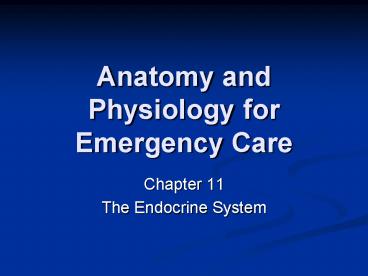Anatomy and Physiology for Emergency Care - PowerPoint PPT Presentation
1 / 36
Title:
Anatomy and Physiology for Emergency Care
Description:
Compare the similarities between the endocrine and nervous systems ... Describe how endocrine organs are ... The C Cells of the Thyroid Gland: Calcitonin ... – PowerPoint PPT presentation
Number of Views:200
Avg rating:3.0/5.0
Title: Anatomy and Physiology for Emergency Care
1
Anatomy and Physiology for Emergency Care
- Chapter 11
- The Endocrine System
2
Objectives
- Compare the similarities between the endocrine
and nervous systems - Compare the major chemical classes of hormones
- Explain the general mechanisms of hormonal action
- Describe how endocrine organs are controlled
3
Objectives
- Discuss the location, hormones, and functions of
the following glands and tissues pituitary,
thyroid, parathyroids, thymus, adrenals, kidneys,
heart, pancreas, testes, ovaries, and pineal
gland - Explain how hormones interact to produce
coordinated physiological responses
4
Objectives
- Identify the hormones that are especially
important to normal growth, and discuss their
roles - Explain how the endocrine system responds to
stress - Discuss the results of abnormal hormone
production - Discuss the functional relationships between the
endocrine system and other body systems
5
An Overview of the Endocrine System
6
An Overview of the Endocrine System
- Structure of Hormones
- Hormones and the Cell Membrane
- Hormones and Intracellular Receptors
7
An Overview of the Endocrine System
- Control of Endocrine Activity
- Direct Negative Feedback Control
- Hypothalamus and Endocrine Regulation
8
The Pituitary Gland
- Anterior Pituitary Gland
- Hypophyseal Portal System
- Hypothalamic Control of the Anterior Pituitary
- Hormones of the Anterior Pituitary
- TSH
- ACTH
- FSH
- LH
- PRL
- GH
- MSH
9
Anatomy and Orientation of the Pituitary Gland
10
Hypophyseal Portal System
11
Feedback and Control of Endocrine Secretions
12
The Pituitary Gland
- The Posterior Pituitary Gland
- ADH
- Oxytocin
13
Pituitary Hormones and their Targets
14
The Thyroid Gland
- Thyroid Follicles and Thyroid Hormones
- The C Cells of the Thyroid Gland Calcitonin
15
Homeostatic Regulation of Calcium Ion
Concentrations
16
The Parathyroid Glands
- PTH
17
The Thymus
- Relatively enormous in newborns
- Reaches maximum size just before puberty
- Thymosins
- Key role in development and maintenance of normal
immunological defenses
18
The Adrenal Glands
- The Adrenal Cortex
- Corticosteroids
- Mineralcorticoids
- Androgens
- The Adrenal Medulla
19
The Kidneys
- Calcitriol
- Erythropoietin
- Renin
20
The Heart
- Cardiac muscle cells in right atrium
- Atrial natriuetic peptide (ANP)
21
Endocrine Tissues of the Digestive System
- The Pancreas
- Regulation of Blood Glucose Concentrations
22
Regulation of Blood Glucose Concentrations
23
Endocrine Tissues of the Reproductive System
- The Testes
- Interstitial cells
- Androgens
- Testosterone
- Sustentacular cells
- The Ovaries
- Follicles
- Estrogens
- Corpus luteum
- Progesterone
24
The Pineal Gland
- Melatonin
- Slows the timing of sexual maturity
- Acts as an antioxidant
- Establishes day-night cycles of activity
25
Patterns of Hormonal Interaction
- Hormones and Growth
- Growth hormones
- Thyroid hormones
- Insulin
- Parathyroid hormone
- Gonadal hormones
- Hormones and Behavior
- Hormones and Aging
26
General Adaptation Syndrome
27
Integration with other Systems
28
Summary
29
Emergency Care Applications
- Chapter 11
30
Overview of the Many Facets of Endocrine Systems
Disorders
31
Diabetes Mellitus
- Type I Diabetes Mellitus
- Type II Diabetes Mellitus
- Emergency Complications of Diabetes
- Hypoglycemia (Insulin Shock)
- Diabetic Ketoacidosis (Diabetic Coma)
- Nonketotic Hyperosmolar Coma
32
Intravenous Glucose Administration
33
Disorders of the Thyroid Gland
- Graves Disease
- Thyrotoxic Crisis (Thyroid Storm)
- Hypothyroidism and Myxedema
34
Disorders of the Thyroid Gland
35
Disorders of the Adrenal Glands
- Hyperadrenalism (Cushings Syndrome)
- Adrenal Insufficiency (Addisons Disease)
36
Summary































